Our History
Discover the rich history of Rougham Estate, near Bury St Edmunds: a captivating journey through time and heritage. Nestled in the rural heart of Suffolk, this beautiful Estate has stood as a testament to elegance and cultural significance for generations. For over 2000 years it has witnessed epochs of change while preserving this part of the region’s cultural legacy. Explore the narratives woven into the very fabric of Suffolk’s history, as we unveil stories of opulence, resilience, and the enduring charm that defines this historical gem.
Scroll to see our story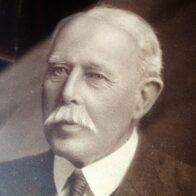
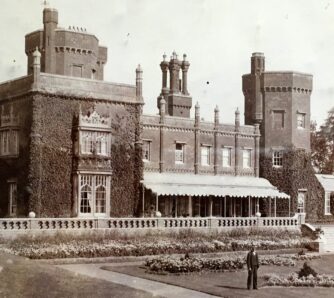
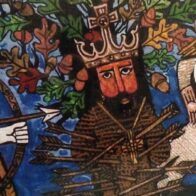
300 AD
Roman Occupation
At the southwest corner of the Estate lies the Eastlowhill tumulus which dates back to the Roman occupation of Britain.
Read more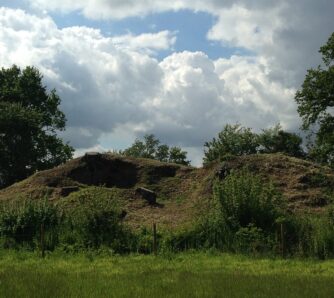
410
The villa gradually collapsed
After the Romans left Britain in around 410 AD, the villa probably gradually collapsed and the land around would have slowly been farmed less intensively and some eventually abandoned.
600
Angles and Saxons
By 600 AD new invaders arrived from the east called Angles and Saxons, coming from modern day Denmark and Germany. They seem to have integrated with the local people who were beginning to become Christians. Britain had broken up into small kingdoms and here we had the Kingdom of East Anglia centred on Suffolk and Norfolk.
869
The last King of East Anglia
The last King of East Anglia was Edmund who was famously killed by the Danes in 869 AD. The place of his execution is uncertain but one strong contender is the neighbouring village of Bradfield St Clare and it is even possible that King Edmund spent some of his last hours at Kingshall, Rougham, which would place Rougham at the very centre of events back in the late ninth century.
980
Ulfketel, Earl of East Anglia
The manor of Rougham was later owned by a powerful Saxon noble with the amazing name of Ulfketel. He was earl of East Anglia in the late tenth century and was married to the King of England’s sister. This was still the time of the Viking invasions. Ulfketel was Christian and, perhaps in an effort to earn points with the Almighty, he gave the manor of Rougham, along with several others, to the newly-formed abbey of Bury St Edmunds, where the body of King and now Saint Edmund lay buried. It doesn’t seem to have worked as Ulfketel was promptly killed by the Danes at the next big battle he attended.
1020
Abbey of Bury St Edmunds
Rougham’s lands formed part of the huge estate of the Bury St Edmunds Abbey from 1020, for the next 500 years.
1327
The great riot of 1327
In 1327 there was the great riot, when the Bury town’s people rose up against the abbey and seem to have destroyed much of Rougham village including Rougham church in the process.
1539
Dissolution of Monasteries
In 1539 the vast abbey at Bury St Edmunds was dissolved by Henry VIII and the Rougham lands passed to the Drury family who were already the top family in the area. The Drury’s were a powerful family whose name is attached to Drury Lane in London and they had branches all over East Anglia. They owned the Estate lands until the English Civil War.
Circa 1550
Blackthorpe Barn Built
The Blackthorpe Barn was built around 1550, probably by John Drury, having acquired the manor of Rougham through the dissolution of the great Benedictine abbey at Bury St Edmunds.
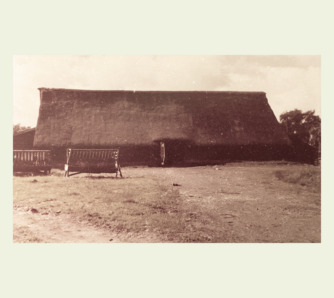
1642
English Civil War
At this point the Estate got sold off in two parts which then followed separate courses for the next 150 years. One half centred on Rougham Place and found itself linked to Robert Walpole (Britain’s first prime minister) and then to the slave trade under the notorious Davers family who made their money in sugar in Barbados.
1680
Roger Kerington
The other half of the Estate, under Roger Kerington, had a new glamorous hall built at the heart of the Estate in the years following the restoration of Charles II around 1680.
1790
Roger Kedington
After nearly 150 years of separation the two halves of the Estate become joined again under Roger Kedington in the years around 1790. This colourful character was a vicar and had three wives and a mistress (only one wife at a time!). Disappointed at not being made a bishop, he spent his energies on enlarging and reuniting the Rougham Estate and looking after his wives and mistress. When feeling in playful mood he would move in with his mistress Sarah Balls, whom he called his shepherdess, in a house built on the other side of the road from the hall, which he called the Cottage. This cottage boasted its own icehouse and was quite spacious. At other times he returned across the road, put on his clerical robes and rejoined which ever wife he had on the go at the time. He only had one legitimate child, a daughter called Jane Judith.
1813
Two halves reunited
The common lands at Rougham were enclosed in 1813 which enabled Roger Kedington to expand the size of the Estate as well as reuniting it with the Rougham Place half.
1818
Jane Judith Bennet
Kedington died in 1818. His heir was his daughter Jane Judith and her husband, Philip Bennet from Essex. Philip was eager to spend his new found wealth on building a new hall…
Read more
1893
James Johnstone
Eventually the Estate was sold in 1893 to James Johnstone, the owner of the London Evening Standard newspaper, who gave it to his son Edwin for his 21st birthday present. Quite a present! Edwin and his wife Marion Ada Yeo stayed for only 11 years but during that time they made huge changes to the Estate, building cottages and houses, placing a clock on the stumpy tower of the gatehouse, building a generator house for the hall, so supplying it with electricity and hot water.
1904
George William Agnew
In 1904 the Estate was bought by George William Agnew, the great grandfather of George Agnew the current owner, who had made his money as an art dealer in London …
Read more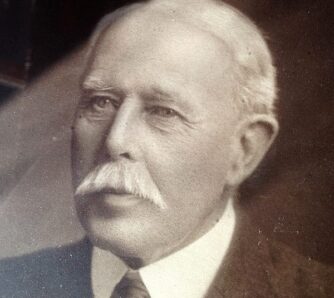
1906
G W Agnew stands for Parliament
George William Agnew stood as a Liberal for parliament in 1906 and won the West Salford seat. To celebrate his victory, he had a group photograph taken of himself with the outdoor Estate staff …
Read more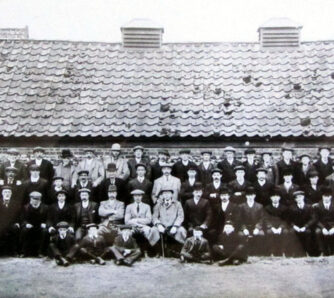
1913
Flower Shows
During the years before the first World War, Sir George held an annual flower show at Rougham Hall, at the end of May. The last pre-war flower festival was held on 27 May 1914.
1914
World War I
Suddenly this blissful time stopped in the summer of 1914. War was declared. George William Agnew’s two sons, Jack and Colin, went off to war. Jack later found himself at Gallipoli, an experience which scarred him for life.
1916
Zeppelin Raid
Life at the hall was altogether quieter during these years, with one exception which occurred during the spring of 1916. A famous zeppelin raid over East Anglia …
Read more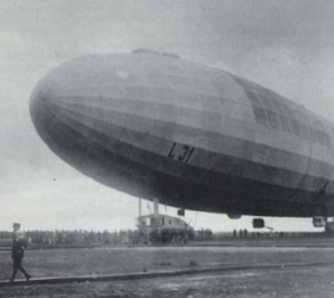
1918
End of World War I
At the end of the war Jack Agnew returned home only to find that the agent who had looked after the management of the Estate in his absence had been fiddling the books for years and had run off with the Estate books and possibly more than a little cash. Jack decided to take matters in hand himself and, with his faithful wartime servant Arthur Daniels beside him, they began running the Estate and continued like this until his Jack’s death in 1957.
1940
The Bombing of Rougham Hall
During the Second World War, the realities of life hit home even harder. In September 1940 Britain was on invasion alert. The retreat from Dunkirk had happened during the early summer, closely followed by the Battle of Britain and then in September the London blitz started. The park at Rougham Hall contained a munitions dump and a number of troops were camped in the park, largely to guard these vital supplies. There were armed guards on the gates, barbed wire and lots of comings and goings. It would not have been hard to mistake all this activity for signs of a military headquarters being set up. This is probably the message that reached Berlin because on the night of Monday 23 September 1940 a single bomber flew over Rougham Hall, dropping flares for a few minutes, before it dropped a bomb straight through the centre of the house and it exploded down in the cellar…
1941
Rougham Airfield built
An airfield was built in Rougham in 1941. When the Americans joined the war after Pearl Harbour they took over the new base. At its height three thousand men were stationed there flying B17…
Read more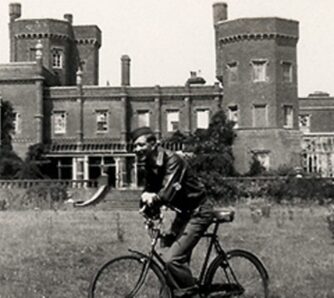
1951
The Suffolk Show
In 1951 the Suffolk Show came to Rougham and was located on the Rougham Estate’s largest field, the then 75 acre East Field. This was probably the largest public event ever to happen in Rougham!
Read more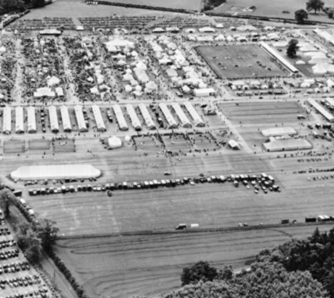

1970
Green Deserts and Rougham Tree Fairs
During the late 1970s John Agnew, in conjunction with others created Green Deserts, a charity dedicated to fighting the spread of deserts throughout the world by the planting tree shelter belts…
Read more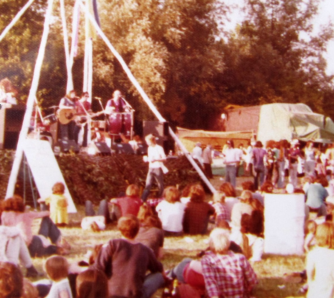
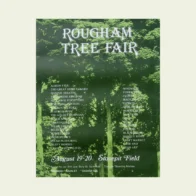
1994
Rougham Airfield
From 1994 until his death in 2011 John Agnew became one of the most powerful supporters of the plans to restore Rougham airfield and its control tower.
Read more
2002
Champion Christmas Tree Grower
Rougham Estate is awarded Champion Grower by the British Christmas Tree Growers Association and supplies the Christmas tree outside the front of No. 10 Downing Street for Christmas 2002.
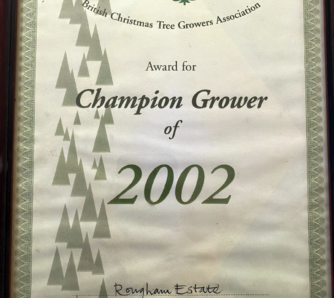
2010
Rougham Estate Trust
The Rougham Estate Trust is created by John and George Agnew to create a lasting legacy and to secure the future of the Rougham Estate.
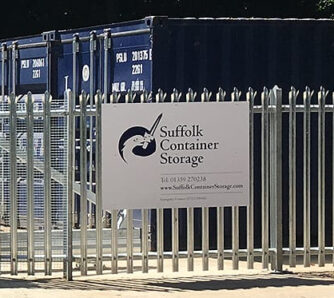
2019
New Rougham Estate logo
Based upon the Agnew crest, a new logo was created for Rougham Estate by Adrian White. You can read more about it here

2021
Rougham Sunflowers and Pumpkins
Rougham Sunflowers and Pumpkins are established and instantly become a roaring success with the public.

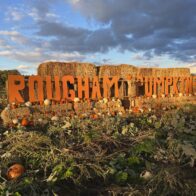
2023
Roots Café
Roots Café is opened for the first time after many years in the planning. The opening of the café is the start of an all-year offering being created on the Rougham Estate for the public.
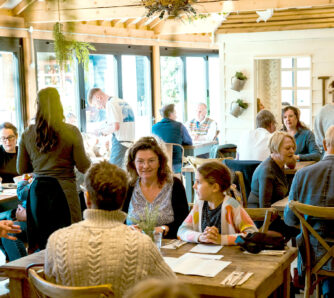
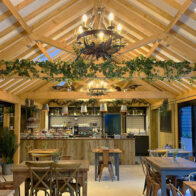
2023
Rougham Estate team 2023
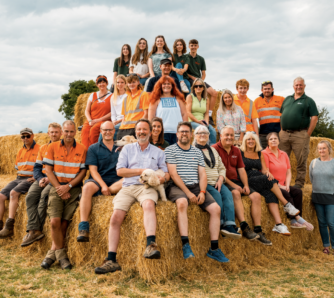
2024
Shop open all year round
The Christmas Shop opened its doors in January 2024 as the Garden Room Shop, bringing a carefully curated selection of lifestyle and garden finds and beautiful gifts to Rougham Estate, open all year.
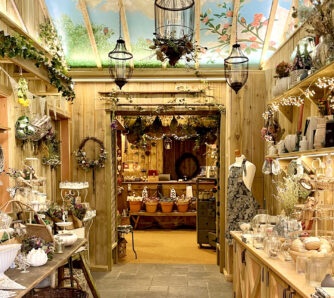
2024
Sunken Garden
In May the sunken garden opened, including a waterfall and pond area and a raised decking extension to the café. This serene area is designed to be a tranquil and calm environment to enjoy nature.
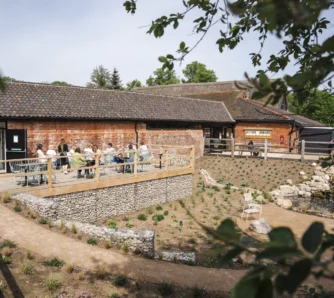
300 AD – Roman Occupation
An important Roman family lived in a villa nearby, probably around 300 AD, and farmed the area around.
1818 – Jane Judith Bennet
Roger Kedington died in 1818. His heir was his daughter Jane Judith and her husband, Philip Bennet from Essex. Philip was eager to spend his new-found wealth on building a new hall, to the north of the main road. This was done under the direction of the fashionable architect Thomas Hopper, who also did work for the Prince Regent at Carlton House in London, building a vast conservatory for him where the prince used to lay on the most extravagant parties. During the nineteenth century four generations of Philip Bennet lived at Rougham, but as time passed they seemed to lose interest in the place.
1893 – James Johnstone
Eventually the Estate was sold in 1893 to James Johnstone, the owner of the London Evening Standard newspaper, who gave it to his son Edwin for his 21st birthday present. Quite a present! Edwin and his wife Marion Ada Yeo stayed for only 11 years but during that time they made huge changes to the Estate, building cottages and houses, placing a clock on the stumpy tower of the gatehouse, building a generator house for the hall, so supplying it with electricity and hot water.
Edwin didn’t forget the village community for whom he built a reading room where people could sit in the warm, read the papers and drink tea and he provided a large modern organ for Rougham Church which is still in use today. He had the hall gardens redesigned by George Paul, the famous rose grower and designer, and redesigned the driveways also. His wife Marion pursued her fascination with rare birds by funding expeditions to the Philippines. Then suddenly the newspaper that was paying for it all got into trouble and in 1904 the Estate had to be sold again.
1904 – George William Agnew
In 1904 the Estate was bought by George William Agnew, the great grandfather of George Agnew the current owner, who had made his money as an art dealer in London selling English paintings to the hugely rich industrialists of northern England and then to the even richer American industrialists from across the Atlantic.
He immediately had the hall enlarged, which sounds a strange thing to do, but the hall had few bathrooms and toilets and limited bedrooms. The Johnstone family had had no children, whilst George William had seven, all reaching marriageable age, and indeed it was the father-in-law of one of these who designed the extension, turning what was a glorified bachelor pad into a family home.
1906 – G W Agnew stands for Parliament
George William Agnew stood as a Liberal for parliament in 1906 and won the West Salford seat. To celebrate his victory, he had a group photograph taken of himself with the outdoor Estate staff, mostly gamekeepers and gardeners. Life went on in the house. The Edwardian years before the First World War look like a blissful time for the wealthy. Photographs of tennis parties, weddings and flower festivals fill the record.
1916 – Zeppelin Raid
Life at the hall was altogether quieter during these years, with one exception which occurred during the spring of 1916. A famous zeppelin raid over East Anglia happened during the night of 31 March and 1 April. One of the airships bombed Bury St Edmunds and flew close over Rougham Hall. Sir George (he had recently inherited a baronetcy for services to the arts from his father) was sleeping in one of the picturesque towers. He grabbed his deer stalking rifle and rushed up onto the tower roof from where he opened fire on the airship. Not surprisingly the zeppelin continued on its way relatively unscathed and Sir George went back to bed!
1940 – The Bombing of Rougham Hall
During the Second World War, the realities of life hit home even harder. In September 1940 Britain was on invasion alert. The retreat from Dunkirk had happened during the early summer, closely followed by the Battle of Britain and then in September the London blitz started.
The park at Rougham Hall contained a munitions dump and a number of troops were camped in the park, largely to guard these vital supplies. There were armed guards on the gates, barbed wire and lots of comings and goings. It would not have been hard to mistake all this activity for signs of a military headquarters being set up.
This is probably the message that reached Berlin because on the night of Monday 23 September 1940 a single bomber flew over Rougham Hall, dropping flares for a few minutes, before it dropped a bomb straight through the centre of the house and it exploded down in the cellar. One whole wing of the house vanished but miraculously no one was hurt.
The butler, Mattins, was having his night off as it was a Monday. It was his job to wake the house in the event of an air raid. In his absence no one else felt that they had the authority to wake the house. Had he been there, the standard procedure was for everyone to go down into the cellar, which was precisely where the bomb fell. They would almost certainly all have been killed.
The night after the bombing, the English language radio broadcast from Berlin given by William Joyce (Lord Haw-Haw) is supposed to have said that the house of the richest Jew in Britain had been bombed the night before.
Rushbrooke Hall in the neighbouring village was owned by the Rothschild family and it is possible that the Germans thought that they lived at Rougham rather than Rushbrooke, but this would hardly have justified an air raid in the middle of the Blitz when all London lay there waiting to be bombed.
Following the bombing, life at the hall came to a grinding stop. Sir George, now aged 89, went to stay with family in Thurston. The hall lay open to the elements. An auction was held, but with petrol rationing and other wartime restrictions, few came and fewer bid for anything. Large items were given away to anyone who could take them before they were ruined by the weather. The hall remains a ruin to this day.
Mattins’ services were no longer required. He was found a job with a London family who needed someone to look after their town house during the Blitz whilst they sensibly moved elsewhere. Mattins had keys for the whole house including the wine cellar. George William Agnew didn’t really drink wine so the cellar at Rougham only contained a little wine for guests. Things were different in London. The fully-stocked wine cellar there proved irresistible to Mattins who set about drinking his way through it. He died some while later of cirrhosis of the liver.
1941 – Rougham Airfield built
An airfield was built in Rougham in 1941. When the Americans joined the war after Pearl Harbour, they took over the new base. At its height three thousand men were stationed here flying B17 Flying Fortresses in bombing raids over occupied Europe. The airfield control tower has now been made into a museum, recording the history of the airfield and the men that were stationed there.
In 1944 two American airmen went up to the ruined hall on their day off. One photographed the other on his bike in front of the building.
1951 – The Suffolk Show
In 1951 the Suffolk Show came to Rougham and was located on the Rougham Estate’s largest field, the then 75 acre East Field. This was probably the largest public event ever to happen in Rougham!
In the weeks leading up to the show the weather had been very wet and concerns were voiced as to how the East Field would cope with all the people and vehicles moving around on it. Sir John Agnew, the owner of the Rougham Estate at the time, commented that ‘the 75 acres is very light land and no amount of water will make a great deal of difference’. Clearly they were all worried! As it turned out, the weather was dry with clear blue skies but a cold wind; very similar to more recent shows.
The two-day show attracted over 34,000 visitors with some from abroad including the United States. It was described in the Bury Free Press as a small canvas town with trade stands ranging from humble tents to ‘futuristic’ style buildings which might have come straight from the Festival of Britain exhibition. There were four miles of fencing and 1800 hurdles for the cattle pens, and a record number of cattle at the show, which was generally regarded as a great success.
1970 – Green Deserts and Rougham Tree Fairs
During the late 1970s John Agnew, in conjunction with Harry Hart, Loretta Quartey, Henry Streatfeild, Steve Sampson and others created Green Deserts, a charity dedicated to fighting the spread of deserts throughout the world by the planting of tree shelter belts. They undertook work in various countries including the Sudan.
The funding for this charity was generated largely by a series of highly popular fairs which took place in Rougham under the title of the Rougham Tree Fair. They formed part of a group of East Anglian fairs known as the Albion Fairs. Their theme was that of a reinvented rural lifestyle, embracing alternative technology, eastern philosophy, alternative medicine, traditional crafts, vegetarianism, music and ceremony. These fairs hit the mood of the times and ran from 1978 to 1982, raising much needed funds for the charity’s work abroad.
‘I was at the Rougham Tree Fair in 1979 and it’s stayed with me ever since – just seeing the poster of the fair gave me a jolt of excitement. The atmosphere was unique, gentle and joyous. I loved it.’ Yvonne
1994 – Rougham Airfield
Over the years John put on many events at the airfield, the most popular of which were The Rougham Air Displays and Wings Wheels and Steam. Thousands of enthusiasts flocked to Rougham Airfield to experience these spectacular shows that John Agnew put on each year. Highlights would often be visits by Spitfires and Hurricanes with pilots such as Charlie Brown putting on unforgettable aerobatic displays in these historic aircraft. The B17 Sally B from the Imperial War Museum at Duxford became almost an annual attraction. Flying Fortresses like this were flown by the Americans from Rougham during World War II.
The Rougham Airfield Control Tower has been restored and is now a museum which opens to the public each month and is well worth a visit. It is an appropriate legacy for all the airmen who risked their lives flying from Rougham and also for John who helped to bring so much of this about.




